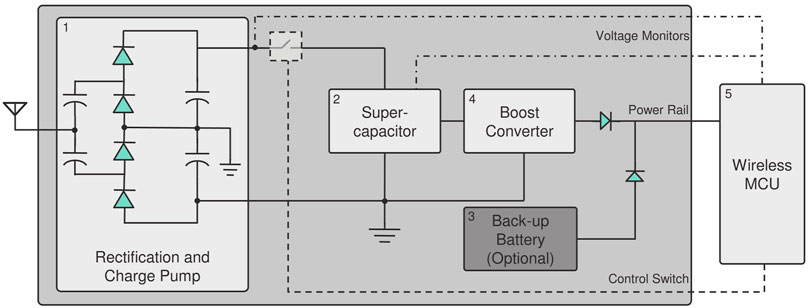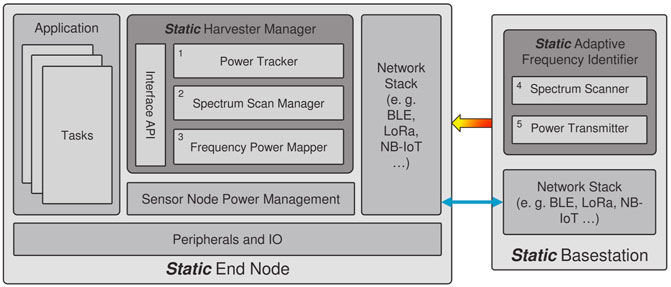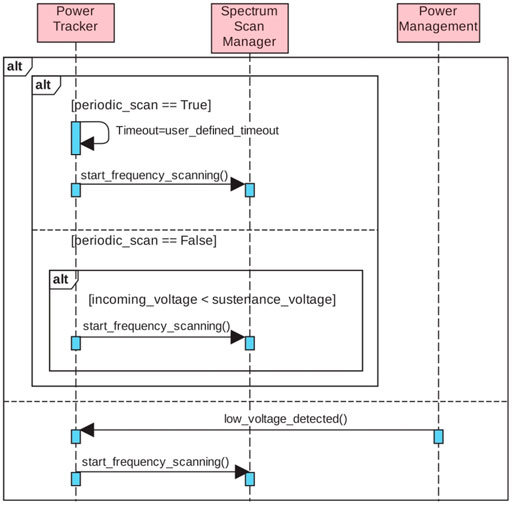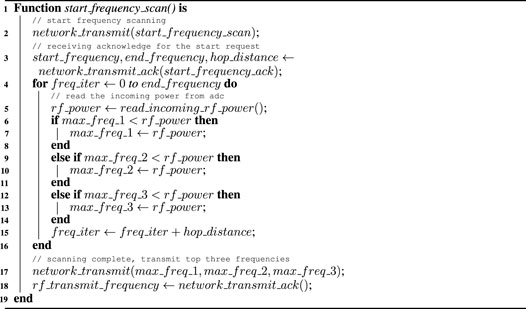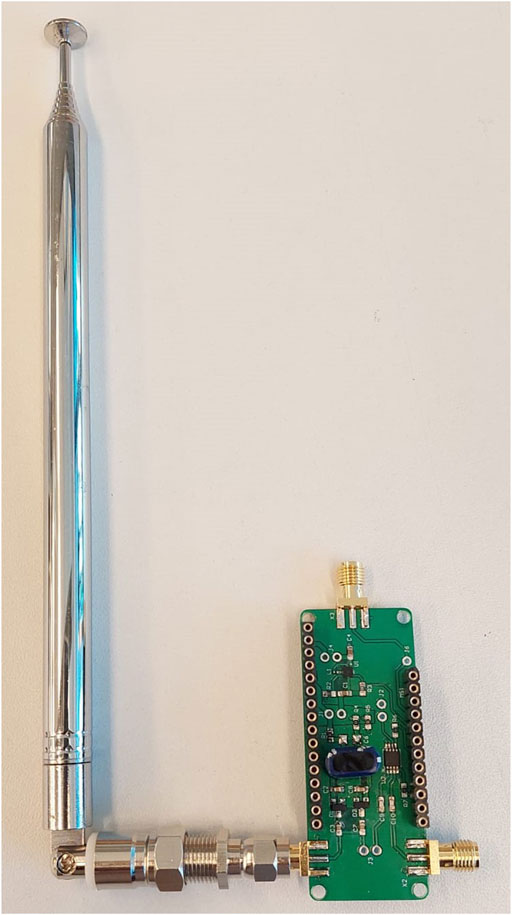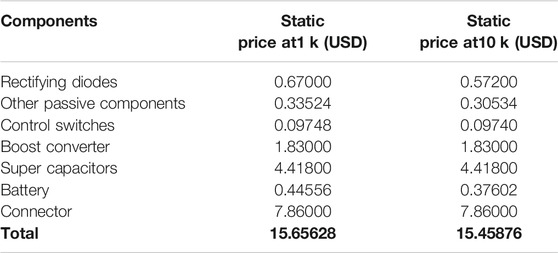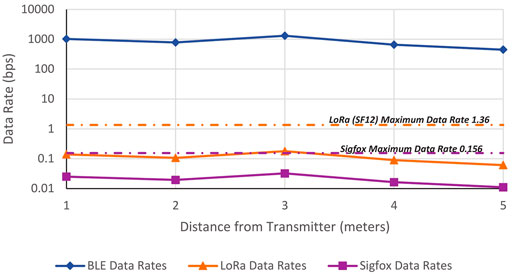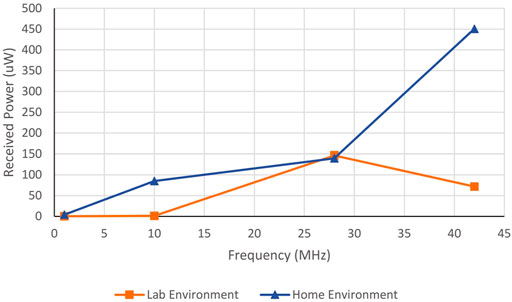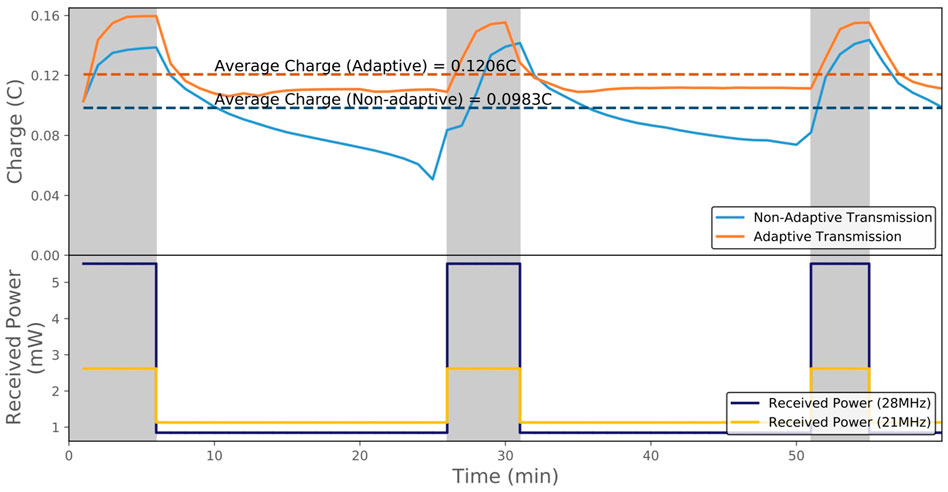- 1imec-DistriNet, Computer Science, KU Leuven, Leuven, Belgium
- 2Research Intelligent IoT and Computing X, Bosch, China
- 3CSSE, Xi’an-Jiaotong Liverpool University, Liverpool, China
The Internet of Things (IoT) is composed of wireless embedded devices which sense, analyze and communicate the state of the physical world. To achieve truly wireless operation, today’s IoT devices largely depend on batteries for power. However, this leads to high maintenance costs due to battery replacement, or the environmentally damaging concept of disposable devices. Energy harvesting has emerged as a promising approach to delivering long-life, environmentally friendly IoT device operation. However, with the exception of solar harvesting, it remains difficult to ensure sustainable system operation using environmental power alone. This paper tackles this problem by contributing Static, a Radio Frequency (RF) energy harvesting and wireless power transfer platform. Our approach comprises autonomous energy management techniques, adaptive power transfer algorithms and an open-source hardware reference platform to enable further research. We evaluate Static in laboratory conditions and show that 1) ambient RF energy harvesting can deliver sustainable operation using common industrial sources, while 2) wireless power transfer provides a simple means to power motes at a range of up to 3 m through a variety of media.
1 Introduction
Internet of Things (IoT) devices connect the digital and physical worlds by enabling the wireless collection of sensor telemetry and the control of appliances. In order to maximize deployment flexibility and minimize installation costs, the end-nodes which form the data collection fabric of the IoT are most often battery powered. Decades of Wireless Sensor Network (WSN) and Internet of Things (IoT) research has resulted in battery lifetimes of several years within reasonable form factors as reported by Yang et al. (2015), Kim et al. (2018), Jackson et al. (2019), and Thangarajan et al. (2020). However, while battery lifetimes have improved, the maintenance effort required to change them still cannot be scaled to support the coming wave of billions of new devices. Furthermore, operating the end-nodes on a single battery charge throughout the lifetime of the devices constraints the power envelope that is available to the application. Energy harvesting has emerged as a promising approach to these problems. By harvesting energy from the environment and storing it in capacitors, battery lifetime limits may be eliminated as shown by Hester and Sorber (2017), Colin et al. (2018), and Yang et al. (2019). Alternatively, as was presented by Thangarajan et al. (2020), harvested energy may be used to expand the energy envelope of an end-node which also uses a long-life battery for reliable operation in industrial deployments.
Prior research has shown that solar harvesters can deliver a stable power supply in outdoor environments. For example: Raghunathan et al. (2005), Corke et al. (2007), Kansal et al. (2007), Gorlatova et al. (2010), and Jackson et al. (2019). However, other harvesting techniques are required for use-cases where predictable illumination is impossible such as in-material sensing or obtaining telemetry from light sensitive processes. In contrast to solar, research on Radio Frequency (RF) energy harvesting remains largely theoretical with relatively few practical reference platforms available to support experimentation. Furthermore, those platforms which do exist such as that by Philipose et al. (2005) are heavily optimized to harvest within a specific frequency band. The dynamism in available ambient RF energy and transceiver characteristics, however, restrict the possibility of deploying such a device in uncertain RF conditions.
This paper tackles this problem by introducing Static, a flexible RF energy harvesting platform that includes a hardware reference design and a suite of supporting software. On the one hand, the proposed hardware design can effectively harvest energy from a wide variety of EM sources; from light bulbs to power tools. On the other hand, the self-adaptive signal processing algorithms of Static tailor system behavior to maximize the efficiency of wireless power transfer. The self-adaptive power transfer approach is inspired from channel hopping techniques adopted in wireless networks, where the communicating devices overcome interference by hopping across different channels in a spectrum. Static, enables such an adaptive approach for efficient energy transfer, on a wider frequency space. We show that, in combination, these techniques reduce the complexity of developing reliable RF energy harvesting applications for a range of power sources.
The scientific contributions of Static are two-fold: 1) the first open reference platform for multi-frequency RF energy harvesting and 2) self-adaptive signal processing software that maximizes the efficiency of wireless power transfer. Static platform supports both ambient RF energy harvesting and wireless power transfer. To the best of our knowledge, Static is the first platform to combine these features, and furthermore provide the first RF energy harvesting platform to adapt power transfer frequency across a wide spectrum in order to maximize efficiency. We evaluate Static in a real world trial, which shows that ambient RF energy harvesting is a feasible solution in industrial settings and that our approach ensures efficient wireless power transfer in the face of dynamic environmental conditions.
The remainder of this paper is structured as follows: Section 2 provides background on the problem of RF energy harvesting and identifies key requirements for the design of Static. Section 3 describes the reference hardware platform and software architecture of Static. Section 4 provides an overview of key implementation details. In Section 5, the proposed hardware-software platform of static is evaluated. Section 6 reviews related work. Section 7 concludes and finally, Section 8 discusses directions for future research.
2 Background
This section provides an overview of RF energy harvesting and related research. Sections 2.1, 2.2 provide the necessary background on RF energy harvesting and power management respectively. Based upon this, Section 2.3 then identifies requirements for the design of Static.
2.1 Radio Frequency Energy Harvesting
Radio Frequency (RF) energy harvesting gathers energy from either ambient or purposefully transmitted radio energy, which is conditioned, rectified and stored for future use. RF energy density is very low in comparison to solar, thermal or kinetic sources, which makes harvesting difficult. Furthermore, RF harvesting efficiency varies due to factors such as transceiver characteristics, input-output impedance and the environment. This leads to a dynamic power envelope as described by Saeed et al. (2018). Ambient RF energy may be harvested from the stronger near field, at a distance of less than a few wavelengths or the weaker far field at much longer ranges. Energy may also be harvested across a broad frequency range; from kHz to GHz. Lower frequencies offer longer range at the expense of larger antennas and vice versa.
Zungeru et al. (2012) discuss the challenges of RF energy harvesting in WSN and, through theoretical analysis identify the amount of power that is made available from common ambient RF energy sources. Through an analysis of the power available from AM radio stations, GSM base stations, mobile phones and WiFi routers, the authors predict power densities that range from 800 μW/m2 (a 100 W GSM base station at 100 m range) to 400 nW/m2 (a 0.5 W mobile phone at 10 m). This is several orders of magnitude lower energy density than a modern solar panel, which produces between 150 and 200 W/m2. This low level of available RF energy has tended to drive research in the direction of developing very efficient RF energy harvesting platforms that are deeply optimised for a specific RF energy source.
Sample et al. (2008) contribute a programmable battery-free sensing and computational platform namely WISP (Wireless Identification and Sensing Platform) for sensor-enhanced Radio Frequency IDentification (RFID) applications. The WISP architecture allows the device to harvest energy from the incoming RF energy transmitted by an RFID reader operating at 915 MHz. In compliance with the Electronic Product Code (EPC) Class 1 Generation 1 protocol, WISP supports efficient backscatter communication. Building upon WISP, Zhang et al. (2011) developed UMass Moo, a passively powered RFID sensing device that harvests energy from, and communicates with, an Ultra High Frequency (UHF) RFID reader. Moo expands the experimental capabilities of WISP in terms of processing power, memory and sensor connectivity.
Hester et al. (2015) present Flicker, a platform for quickly prototyping battery-less embedded sensors. Flicker is an extensible, modular, “plug and play” architecture that supports RFID, solar, RF and kinetic energy harvesting together with passive and active wireless communication and a wide range of sensors. The RFID harvester of Flicker builds on the design of Moo.
Wiliot (2018) developed a battery-free Bluetooth tag that obtains energy by harvesting ambient RF energy from the environment, thereby leveraging the abundant deployments of Bluetooth and Wi-Fi. Using the harvested energy, the Wiliot tag is capable of sending a standard Bluetooth advertising packet to any device with Bluetooth Low Energy (BLE) capabilities within a range of a few meters.
Maeng and Lucia (2020) propose CatNap, a system to enable reliable event-driven execution on RF-based energy-harvesting devices using a dipole antenna and a P2110-EVB harvester operating at 915 MHz. Catnap is based upon a combination of commodity off-the-shelf hardware, a power management circuit, and a custom programming model with events, tasks, a charge scheduler, a compiler, and associated run-time support. By continually measuring the production and consumption of energy, CatNap can robustly support event-driven execution even in the face of short- and long-term energy fluctuations.
An ideal RF energy harvesting platform would support a wide frequency range in order to maximize its applicability in ambient energy harvesting. This will necessitate adapting its operation to suit different physical antennas, environmental conditions and power availability; thereby making the most of available environmental power. On the other hand, sufficient ambient RF power can never be guaranteed and support for Wireless Power Transfer (WPT) is therefore required.
2.2 Power Management for Energy Harvesting Devices
RF energy harvesting offers limited power and furthermore, RF energy is likely to be dynamic, varying according to equipment usage patterns, transmitter power levels and wireless channel conditions. Managing this small and dynamic power source efficiently to deliver reliable operation is one of the critical challenges for the next generation of energy harvesting IoT networks. A significant body of research has been conducted on power management for energy harvesting systems, which includes hardware, software and hybrid approaches as outlined below.
Hardware reference designs provide a template for efficient power management in energy harvesting scenarios. Hester et al. (2015) introduced United Federation of Peripherals (UFoP), a reference design for federated energy storage, which uses a dedicated capacitor per hardware peripheral. This approach enables faster charging and prevents any single peripheral from exhausting available charge. In their subsequent work, Hester and Sorber (2017) present Flicker adding support for plug-and-play peripherals, which can be customized at development time.
Energy-aware scheduling maximizes reliability by matching energy demand to available supply by modifying the rate at which programs are executed. In the context of ambient RF energy harvesting, dynamic approaches are of particular interest as they can deal with the inherent dynamism of RF environments. Yang et al. (2019) tackle the problem of dynamic energy availability and consumption through an energy-aware task scheduler, which tailors the rate at which software executes in order to match energy harvesting supply and system demand using an algorithm inspired by TCP congestion control. This approach ensures sustainable operation in the face of environmental dynamism. Thangarajan et al. (2020) extend this approach to guarantee a specified multi-year lifetime for hybrid systems which combine long-life batteries with capacitor based charge storage. HyPer enhances device performance by using energy harvesting when possible and falling back to the battery when required to maintain operation.
Hybrid hardware/software approaches combine a platform reference design with OS support. For example, Maeng and Lucia (2020) propose the CatNap framework that provides an energy-aware programming model, allowing the developer to flag a subset of her code as time-critical. CatNap then isolates energy for this time-critical code section and provides interfaces to define degraded modes of operation in cases where the normal schedule cannot be maintained. Colin et al. (2018) present the Capybara, a hardware/software energy harvesting platform, which allows the developer to dynamically tailor energy storage capacity to application demands using a re-configurable capacitor array and a software API that enables easy integration with application software.
In our view an ideal power management approach for RF energy harvesting follows a hybrid power-management approach, minimizing developer complexity to the greatest possible degree by encapsulating a complete solution to the RF energy harvesting problem. At the same time, this solution should maximize generality by supporting integration with a wide range of application processors unlike prior work such as Colin et al. (2018), Maeng and Lucia (2020), and Thangarajan et al. (2020). Finally, as shown by the related work discussed above, adaptive mechanisms are required to optimize energy harvesting to suit dynamic environmental conditions.
2.3 Requirements
Based upon the background analysis performed above, we identify the following key requirements for the design of Static:
(1) Efficient wide-band energy harvesting: An efficient RF harvesting circuit is required that is capable of rectifying a wide range of RF energy sources, from low frequency motor noise to high frequency communication signals. While this naturally sacrifices efficiency in comparison to narrow-band harvesters proposed by Zhang et al. (2011), Liu et al. (2013), Naderi et al. (2014), and Miller et al. (2020), it maximizes the applicability of the harvester in diverse application scenarios.
(2) Self-adaptive energy management: As described previously, RF energy availability is extremely dynamic, being driven by the strength and proximity of sources as well as environmental conditions. An ideal RF energy harvester should adapt to these changing conditions in order to minimize development complexity.
(3) Low power operation: The energy overhead of all functionality must be kept as low as possible to maximize the energy that is available to the application processor and its host software.
(4) Support for diverse processors and radios: Prior energy harvesting platforms have tended to contribute a monolithic solution that combines sensing, computation and communication with energy harvesting. This limits the reusability of these platforms. A drop in power module is required that preserves freedom in processor, sensor and radio selection.
3 System Architecture
The design of Static strives to maximize flexibility and simplicity for IoT application developers while delivering an effective RF energy harvesting solution.
Simplicity is assured at the hardware level through the use of low-cost Commercial Off-The-Shelf (COTS) components. At the level of software, Static firstly provides a self-adaptive software stack that continually optimizes Wireless Power Transfer (WPT) based upon platform-specific configuration details and changing environmental conditions. Secondly, Static provides a simple and intuitive software API that enables applications to monitor available energy, track WPT performance and react to changing power availability.
Flexibility is enabled through a plug-and-play design philosophy that includes user-replaceable antennas in combination with a standard PCB footprint that enables easy integration with a wide range of existing application boards. Furthermore, Static eschews frequency-specific optimizations such as a tailored matching circuit in favor of a less optimal energy harvesting circuit that can handle a broader range of frequencies.
The remainder of this section describes the overview of Static platform in Section 3.1, reference hardware platform in Section 3.2 and the wireless power transfer optimization library in Section 3.3. Section 3.4 then concludes by describing the software API through which applications interact with Static.
3.1 Static Overview
Static is designed to support harvesting from various ambient RF sources such as electrical appliances, which consists of a wide frequency range. Static uses the near field effects which offer higher power density compared to radiated power, and the RF-front end is not tuned to a specific frequency. This allows Static to be modular in such a way that energy can be extracted sub-optimally using a COTS wide-band antenna or use infrastructures such as concrete re-bars without rejecting a broad spectrum of ambient frequencies. To overcome the drop in voltage as distance increases, Static introduces a front-end that multiplies the voltage to a level that can be harvested. By adopting such an approach, Static provides a modular and simple ambient RF harvesting front-end.
In addition, when surplus RF power is available within the network or an electrically powered node is available to transfer energy, Static provides an adaptive WPT mechanism. RF power transfer is inefficient and is affected due to various factors determined by the environment where the node is deployed, which tends to change such as movement in malls and moving equipment in lab, creating unpredictable changes in RF power transfer efficiency. To overcome this challenge, Static adopts an adaptive frequency hopping approach. The adaptive WPT method of Static is inspired from Time Synchronous Channel Hopping (TSCH) Infrastructure and Layer (2015) approach of wireless network where the nodes exchanging data, hops across a defined list of channel at agreed time intervals, which improves reliability and overcomes interference. Static follows a similar approach, where it assumes a transmitter with the capability to transmit at a wide range of frequencies, but does not assume the efficiency of power transfer over the entire spectrum. The transmitter runs a Static library that enables an adaptive frequency scanning technique that is initiated by the node that requests energy during which the most efficient wireless power transfer frequency is identified. The node that receives energy, monitors the incoming energy level and maps it to a list of frequencies, from which the frequency with highest energy level is selected. The energy required for the frequency scanning is given by:
where ttransmit and treceive are the time required to transmit and receive a message in the communications network used and Itransmit and Ireceive are the average current consumed during transmit and receive operations, respectively, that is required to synchronize the Static WPT transmitter. Cadp_scan is the platform-specific charge required to measure WPT efficiency using the Analog to Digital Converter (ADC) of the application processor. The energy required for the scanning technique for the reference implementation is described in Sections 5.2.2, 5.2.3 we show that periodic scanning increases the aggregate charge accumulated.
3.2 Reference Hardware Platform
The hardware block diagram of Static is shown in Figure 1. As can be seen from the Figure, Static provides a power supply and charge storage system that can be connected in a plug-and-play fashion to a wide range of application MCUs or development boards. Each element of the hardware design shown in Figure 1 is described below.
(1) Rectification and Charge Pump: RF energy passes from the user-selected antenna through a diode and capacitor network that serves as both a rectifier and a charge pump. Diode selection should aim to minimize switching time and forward voltage drop (e.g. using Schottky RF diodes) and thereby supports a wide range of RF frequencies at low power.
(2) Super Capacitor: A super-capacitor is used as the primary charge storage medium due to its longevity and low source resistance, which enables Static to support energy hungry sensors and a wide range of wireless communication protocols.
(3) Back-up Battery: The optional back-up battery reduces recharge times in cases where power is lost and the super-capacitor discharges below the minimum voltage required by the boost converter. The system is, however, designed to provide sustainable operation using harvested RF energy alone.
(4) Boost Converter: The boost converter delivers a consistent voltage to the application MCU from a dynamic capacitor voltage even in cases where the capacitor voltage is significantly below the required operational voltage.
(5) Wireless MCU: Static is, in principle compatible with any wireless MCU and is designed to support a wide range of MCU extension boards. However, the intermittent nature of RF energy harvesting fits best with connection-less wireless networks such as Bluetooth Low Energy (BLE), LoRa or SigFox as opposed to session-based IoT networks such as 802.11, 6TiSCH or ANT.
3.3 Adaptive Energy Harvesting
Figure 2 shows the adaptive energy harvesting subsystem of Static, which integrates with power management software running on the application MCU using standard serial APIs, as described in Section 3.4. This subsystem executes on the application MCU as a provided library. The Static software stack consists of two components: 1) the Static Harvester Manager running on the end-node and 2) the Adaptive Frequency Identifier running on the base-station. These modules work together to optimize wireless power transfer. The functionality of each block in the Static components are described below:
(1) Power Tracker: During normal operation, the power tracker periodically triggers the adaptive frequency scanning mechanism to determine the optimum RF power transmission frequency. In addition to periodic optimization, adaptive frequency scanning is also triggered in the case that incoming RF energy drops below a predefined voltage threshold, which can be configured through the API.
(2) Spectrum Scan Manager: When a frequency scan trigger is received, the frequency scanner stops the power management mechanism if available, and transmits a message to the basestation to start the scanning process using the spectrum power mapper. At the end of the scan the frequency with highest received power is communicated to the basestation.
(3) Frequency Power Mapper: The Frequency Power Mapper records the WPT efficiency in each frequency band in collaboration with the adaptive frequency identifier running on the base-station. When the mapping is complete, the frequency/power map is reported to Spectrum Scan Manager.
(4) Spectrum Scanner: When the adaptive frequency identifier receives a scan message from the end-node, the spectrum scanner is triggered to transmit power on the supported range of frequencies for a fixed time period. After the transmission is complete, the end-device records the power available in each frequency band and reports the optimal frequency to the base-station.
(5) Power Transmitter: The power transmitter implements wireless power transfer. Until there is a frequency change indication from the spectrum scanner, the power transmitter continues to transmit in the last identified frequency.
The algorithm describing the frequency scanning process is shown in Algorithm 1 and the scanning process is shown in Figure 3. In the algorithm Algorithm network_transmit() and network_transmit_ack() represent technology specific network calls. The call read_incoming_rf_power() uses the ADC of the application MCU to sample the voltage of received RF power.
3.4 Application Programming Interface
Static provides a generic API to configure the adaptive frequency scanning library and receive notifications of power events. The configurable parameters of Static are: brown-out voltage, a callback to halt 3rd-party power management libraries during frequency scanning and a callback to initiate fail-safe behavior when brown-out approaches. The platform specific brownout and low voltage are inform to the Static library using the set API, and when a brownout or low voltage is detected the Static library will call the registered power management handler, the behavior of which is implemented by the application. Apart from these parameters that can ensure safe operation of the application, the scan period can also be set by the application. If this parameter is set, Static runs the runs the adaptive scanning periodically based on the duration set by the application.
typedef void (∗pwrmgtHandler)()
typedef void (∗haltNativePwrmgt)()
void setBrownoutVoltage(uint16_t boVoltage)
void setScanningPeriod(uint16_t sPeriod)
void registerPwrMgtHandler(pwrmgtHandler f1)
void registerHaltPwrMgtHandler(haltNativePwrmgt f2)
void setLowVoltage()
The following section describes a reference implementation of the static design.
4 Implementation
The finished prototype of the Static energy harvesting board is shown in Figures 4, 5 shows Static board with a COTS telescopic antenna used for evaluation. The prototype is implemented in the form factor of an Adafruit feather shield which enables Static to be used as an RF energy harvesting board for a large range of MCUs, equipped with a variety of wireless networks1. Figure 4 shows Static alongside an nRF52832 Bluetooth Low Energy Feather board which was used in our evaluation.
We selected Skyworks SMS7630-005LF Schottky diodes together with 100 nF ceramic capacitors to implement the rectifier and charge pump. This subsystem connects to an Eaton 0.1 F super capacitor, the output of which is boosted to 3.3 V by a MAX17222 boost converter, which powers the application MCU. Table 1 shows bill of materials for the prototype at 1 k and 10 k order volumes.
The super-capacitor and backup battery are connected in an OR configuration, wherein the backup battery takes over whenever the output voltage of the boost drops below 3 v (indicating that capacitor has discharged). The application is notified of brown-out via the serial API. The use of a backup battery enables the boost converter to begin operating 55% more quickly once charge becomes available. This performance gain occurs as the cold-start voltage of our selected boost converter is 880 mV (requiring 88 mC charge). However, it can provide sustainable operation down to 400 mV (40 mC) when power is maintained. In the case that a back-up battery is not used, it is the responsibility of the application developer to ensure sustainable low-power operation in brown-out conditions.
To implement the Static basestation, we used an Atmel SAM3X8E ARM Cortex-M3 to generate a Pulse Width Modulation (PWM) signal at the required frequency. This signal is then boosted to 600 mW using a wide-band COTS power amplifier and transmitted via a 1.2 m omni-directional antenna. The base station is capable of transmitting in seven frequency bands between 10 and 50 MHz; specifically at: 10, 12, 14, 16, 21, 28, 42 MHz.
5 Evaluation
In this section we evaluate the ability of Static to harvest energy from different ambient sources, the efficiency of WPT and the effectiveness of Static’s adaptive frequency selection techniques.
5.1 Ambient Energy Harvesting Performance
Based on the ambient source under test, we customize the antenna system attached to the Static node. The antenna was located as close as possible to the energy source in order to maximize strong near-field effects. We believe that this is reasonable as Static devices will often draw power from the device which they are monitoring (e.g., vibration analysis of power tools or motor bearings). We selected four representative ambient power sources which were easily accessible in our office and laboratory environment. Table 2 summarizes the measured RF power from different ambient sources along with the antenna that was used to harvest energy.
As can be seen from Table 2, Static is capable of harvesting usable energy from a wide range of ambient sources; from lighting through motors to communications equipment. Based upon these power experiments, we demonstrate the ability of Static to support data transmission on three representative IoT networks namely, LoRa, Sigfox and BLE. The power received by Static were recorded while running these electrical appliances and the energy accumulated was calculated, from which the data rates that can be achieved by the different IoT networks were derived. Our evaluation uses previously published energy estimates to calculate data rates: Ramachandran et al. (2017), Gomez et al. (2019), and Dataset, (2021).
• LoRa is a long range low power sub-GHz network, which uses robust Chirp Spread Spectrum (CSS) modulation to achieve a range of up to 20 km in realistic settings. We evaluated the data rates that Static can deliver on LoRa in its longest range settings (Spreading Factor 12 and a transmit power of 14 dBm) with a payload size of 32 B.
• SigFox is another low-power sub-GHz network, which uses narrow-band Differential Binary Phase Shift Keying (DBPSK) modulation to achieve comparable ranges to LoRa. We evaluated SigFox using the following settings: 14.5 dBm transmit power, 100 bps data rate and the maximum uplink message length of 12 B.
• Bluetooth Low Energy (BLE) is a short range 2.4 GHz personal area network technology that is widely deployed in consumer electronics such as phones, laptops and wearable devices. We evaluated BLE using 37 B advertisement beacons (including link layer addresses) at a transmit power of 0 dBm.
Figure 6 shows a rank-ordered distribution of the maximum data rates that can be achieved when using static to power an IoT device with each of the above networks. As can be seen from Figure 6, Static is capable of delivering usable data rates from harvested ambient RF energy. As can be seen from the figure, in a number of cases, Static achieves sustainable data rates that are in excess of 10% of the maximum regulatory limit using only ambient RF energy harvesting. The maximum sustainable data rate was achieved using BLE when harvesting from the Dremel 1000 Rotary Tool (1.37 bps). In cases where these data rates are insufficient, Static also supports dedicated WPT as outlined in the following section.
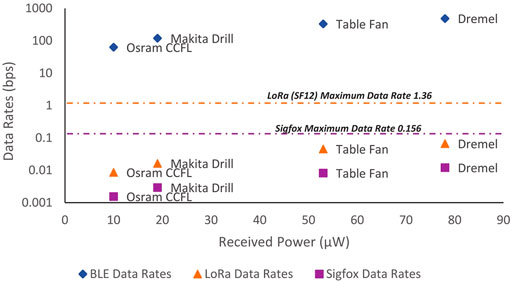
FIGURE 6. Sustainable data rates for BLE, LoRa and sigfox using ambient RF energy harvesting from a range of devices.
5.2 Efficiency of Wireless Power Transfer
In this section, we evaluate the efficiency of Static’s WPT subsystem. We begin in Section 5.2.1 by evaluating the impact of distance on WPT for a fixed frequency configuration. Section 5.2.2 then analyses the costs and benefits of adaptive frequency selection in the case of a BLE network.
5.2.1 Distance vs. Data Rates for Fixed Frequency Wireless Power Transfer
In this section, we evaluate the performance of Static when using different communication networks at different distances from the base-station at a fixed frequency of 28 MHz. A single base station (transmitter) and end-device (receiver) were used in each case. All experiments were repeated 10 times and the results averaged. Figure 7 shows the data rates that Static achieves for each network at a distance of between 1 and 5 m from the transmitter. The power received by Static node were recorded at different distances from the transmitter and the energy accumulated was calculated, from which the data rates that can be achieved by the different IoT networks were derived. The y-axis (data rate) of the plot uses logarithmic scale to be able to represent data rates of all the networks in a single graph for comparison. The drop in data rate is approximately 1.2–1.4× for every meter increase in distance. Additionally, possible multi-path effect in the lab improves the received power. The graph shows an unusual increase in data rate between 2 and 3 m which we believe is also due to the specific multi-path environment of our laboratory. More controlled experiments in an anechoic chamber will be a subject of our future work. At a distance of 1 m, BLE can support over 40 messages an hour (2.88 bps), while LoRa can support 2 messages per hour (0.157 bps) and Sigfox can support approximately 1 message per hour (0.029 bps). However, as is shown in Figure 8, received power varies significantly based upon transmitter frequency and the surrounding environment. For example; in our laboratory environment, the optimal frequency was found to be stable at 28 MHz, while in the author’s home environment, 42 MHz achieved almost 3× higher power transfer. This motivates the need or frequency-adaptive WPT, as evaluated in the following section.
5.2.2 Efficiency of Frequency-Adaptive Wireless Power Transfer
In this section, we evaluate the efficiency gains offered by the adaptive WPT technique of Static. Figure 9 shows the received power at each frequencies and the charge accumulated with and without adaptive transmission over the 60 min experiment timeline. For the purposes of this experiment, the Static board was connected to a BLE node, sending a beacon message every 10 s and frequency adaptation was executed every 5 min. The transmitter begins transmitting at 600 mW for 5 min, followed by 400 mW for 20 min and continues this cycle throughout the 60 min experiment. At 400 mW transmit power, 21 MHz is more optimal, while at 600 mW, 28 MHz is more efficient. From the Figure it can be seen that the average charge accumulated by Static using adaptive transmission is 18.52% higher.
It should be noted that radio communication is significantly more expensive for LPWAN networks due to the power that is required to achieve longer range. While such networks may also benefit from adaptive power transfer, the frequency adaptation period should be extended in line with the energy cost of optimizing the WPT frequency.
5.2.3 Scanning Overhead
The scanning algorithm was implemented in the nRF52840, a representative IoT end-node. The adaptive scanning process exchanges three messages using the Bluetooth radio and the WPT signal strength is measured for each frequency band using the average of five samples from the on-board 12b Analog to Digital Converter (ADC). Each frequency is transmitted for 90 μs, followed by a 20 μs gap, which when extended for the evaluated 7 frequency range completes in 770 μs. The total charge consumed for the frequency scanning process calculated using Eq. 1 on our evaluation platform is 0.481 μC.
5.3 Limitations and Opportunities
While Static delivers promising results, many avenues for improvement remain. This section discusses the limitations of this work along with directions for further optimization.
5.3.1 Tuned Antenna Sub-Systems
Tuned antenna subsystems have been extensively studied in the RF energy harvesting literature: Gollakota et al. (2013), Liu et al. (2013), and Miller et al. (2020). Antennas tuned to a specific frequency exhibit higher efficiency, however this narrows the frequency in which energy can be harvested. However, it should be noted that Static does not impose any restrictions on the type of antenna subsystem that can be connected to its SMA socket. Therefore, in cases where detailed knowledge of the RF environment is available, a tuned antenna can be connected to improve harvesting efficiency.
5.3.2 Antenna Diversity
Transmitting RF signals on multiple antennas can effectively increase the power transferred, however the transmitted RF signals may also interfere destructively resulting in a net drop in harvested energy. This phenomenon is determined by distance between the antennas and the path length as investigated by Naderi et al. (2014). As WPT in Static is performed at low frequencies, the constraint on the distance between the transmitter antennas is lower. Our experiments show that at 28 MHz, adding an additional antenna to the transmitter at a fixed distance of 0.5 m between the antennas doubled the received power from 128.14 to 257.73 μW at a distance of 1.2 m. The destructive interference zones can be experimentally determined by measuring the power output at the rectifier stage of Static.
5.3.3 Power Amplifiers
Static assumes that the base-station is connected to mains power and thus, its transmit power may be arbitrarily amplified up to the regulatory limit (e.g. 4 W on 27 MHz band in the EU). Our current prototype is limited to 840 mW. An improved basestation, would dynamically scale its transmit power to match regulatory limits accross the frequency range. Furthermore, the base-station would ideally feature a dynamically tunable impedance matching network, to maximize efficiency across the frequency range.
5.3.4 Limitations
Static uses low frequency sources and near field effects to capture energy. This allows the Static platform to be untuned to a specific frequency and use a wide-band antenna available either as commercial off the shelf component or as part of the infrastructure such as steel rods in reinforced concrete, copper piping etc. to extract energy that is sufficient to run contemporary low power IoT platforms (Kim et al., 2018; Thangarajan et al., 2020). At higher frequencies, when the near field effect deteriorates and the harvester relies on radiated power, an untuned energy harvester will not yield sufficient power to run sensor nodes, which require tuned antenna sub-systems at a specific frequency, as seen in literature (Liu et al., 2013; Kimionis and Tentzeris, 2014; Iyer et al., 2019). To allow a harvesting from a wide range of frequency at higher end of the spectrum, it requires dynamically tunable antenna subsystems which has been planned as future work. In summary, we expect static to work extremely well for sources ranging from 100 s of KHz to few 100 MHz.
6 Related Work
RF energy harvesting has received significant attention from the research community over recent years. Prior work may be classified as either 1) hardware or 2) hardware-software based approaches.
6.1 Hardware Based Approaches
The majority of prior research has focused on hardware-based approaches, and specifically new designs for ambient RF energy harvesters, such as single/multi/broadband rectifying antennas or rectennas, matching circuits and DC/DC converters. For instance, Shen et al. (2020) introduced a directional 4-port pixel patch rectenna system to harvest ambient RF energy from the GSM-1800 frequency band. Adami et al. (2017) presented a flexible 2.45 GHz wireless power harvesting wristband comprising a rectenna and impedance matching power management that generates a net DC output from as little as −24.3 dBm RF input. Vu et al. (2020) presented a multiband bow-tie antenna (covering 840, 1860, 2,100, and 2,450 MHz) along with a rectifying and power management circuit to condition and store the harvested energy. Similarly, Muncuk et al. (2018) designed a simple RF-EH circuit using a similar rectification approach to Static together with a tunable impedance matching network to power embedded sensors from LTE 700 MHz, GSM 850 MHz to ISM 900 MHz. Li et al. (2020) demonstrated a battery-less wireless sensor tag which is based on a 3-stage Dickson voltage multiplier that can be activated by a dedicated RF power source at a maximum distance of 2.3 m.
A range of sensor platforms have also been developed that communicate through ambient backscatter from FM, TV, WiFi or LoRa signals: Liu et al. (2013), Kellogg et al. (2014), Wang et al. (2017), and Guo et al. (2020). Another stream of work focuses on the use of continuous tone carrier signals over unlicensed spectrum such as: Kimionis and Tentzeris (2014), Vougioukas et al. (2016), and Iyer et al. (2019). Most of these platforms are tuned to harvest energy only on a specific frequency. The deployment of such a system therefore requires prior knowledge of a stable RF environment. In contrast, Static supports less optimal energy harvesting from a wider range of ambient sources, as shown in Section 2.1.
6.2 Hardware-Software Based Approaches
Maeng and Lucia (2020) introduced CatNap, an event-driven RF-based energy-harvesting system that uses a dipole antenna, a P2110-EVB harvester operating at 900 Mhz, simple power management circuits, and a full software stack including programming support. By measuring incoming energy supply and ongoing energy demand, CatNap can adapt to accommodate long-term incoming power fluctuations and variations in system power consumption.
Sample et al. (2008) propose a battery-free Wireless Identification and Sensing Platform (WISP), that is compliant with the RFID (EPC) Class 1, Generation 1 protocol. WISP can transmit 64 bits of data per query and is fully programmable via its integrated 16-bit micro-controller. WISP has no battery and is completely powered via the RF energy transmitted by an RFID reader. WISP has long been the platform of choice for computational RFID (CRFID) research, but it cannot be applied to support energy harvesting research beyond the RFID standard.
Hester and Sorber (2017) present Flicker, a platform for quickly prototyping batteryless embedded sensors. Flicker offers an extensible, modular, “plug and play” architecture that supports RFID, solar, and kinetic energy harvesting together with both passive and active wireless communication. For RFID energy harvesting, Flicker uses the UMich Moo design by Zhang et al. (2011) and harvests energy from a UHF RFID reader. For charge storage, Flicker uses a customisable and decentralised capacitor array. Additionally, the Flicker harvester is equipped with circuitry that enables back-scatter communication.
Mayer et al. (2020) proposed an adaptive and firmware-configurable power unit combining low power integrated circuits. The control and power management circuit enables sub-μA quiescent current consumption. Ju and Zhang (2018) present a novel predictive power management framework for battery-less IoT devices, including algorithms for maximum power point tracking, predictive energy allocation, and adaptive transmission power control. Although the simulation results suggest substantial improvements in the robustness of battery-less IoT devices, complexity and overhead limit the application of this approach to systems with a power consumption below several hundred mW.
Prior work on hardware and hardware-software based approaches tend to be tuned to harvest power on a specific frequency or assume that the hardware is optimized to harvest maximum available power from the surrounding environment. Such approaches are inherently unsuited to dynamic RF environments. Firstly, the ambient RF power varies widely based on location and environment. Secondly, when using WPT, variations in the operational environment will shift the optimal receiving frequency, which requires periodic optimisation of the WPT frequency. In contrast, Static provides a generic platform that simplifies the development of energy harvesting based sensor applications and motivates further research on improving RF-energy harvesting and WPT based energy transfer.
7 Conclusion
This paper has introduced Static, a Radio Frequency (RF) energy harvesting platform that enables both effective ambient RF energy harvesting and flexible Wireless Power Transfer (WPT). In contrast to prior EH platforms, Static is capable of harvesting a wide range of ambient energy sources at different frequencies. Building on this flexibility, Static introduces an adaptive WPT subsystem that can automatically optimize power transfer frequencies in order to maximize performance in different environments.
Evaluation of Static’s ambient RF energy harvesting capability shows that the platform is capable of harvesting sufficient energy from a representative range of common ambient sources to support useful data rates (ranging from approximately 1 message a day in the slowest LPWAN networks to 1 message every 0.6 s in short range networks). The same physical hardware also supports adaptive WPT, enabling data rates of up to 1 message every 0.36 s at a range of 1 m from a 49.5 mW WPT Transmitter. Furthermore, we note that adaptation is critical for efficient WPT with optimal frequencies being affected not only by platform and antenna details, but also by potentially transient environmental considerations. The self-adaptive WPT approach of Static thereby results in gains of up to 18.52% in charge accumulated compared to a static WPT approach.
In addition to the research contributions of Static, we also make our reference platform and software stack open-source and available online. The low complexity of Static’s hardware design in combination with the exclusive use of COTS components ensures the reproducibility of our results and promote experimentation with the Static platform.
8 Future Work
Our future research work will proceed along three fronts.
Firstly, we will investigate the use of higher frequency Wireless Power Transfer (WPT) at up to 2.4 GHz, in order to enable the miniaturization of key radio components such as antennas. In a complementary stream of work, we will further investigate the frequencies of RF energy that are most prevalent in the environment and characterize the efficiency of static in utilizing these different frequency sources in a controlled RF environment such as an anechoic chamber, where we will likewise perform a more in-depth characterization of Static’s WPT functionality.
A second stream of research will investigate how to extend the WPT subsystem of Static to support Simultaneous Wireless Information and Power Transfer (SWIPT) in order to eliminate the need for a separate radio on the application processor. Our approach to SWIPT will investigate multiple approaches including standard radio modulation schemes, cross-talk and back-scatter communication. Furthermore, we will investigate how the frequency adaptive WPT system of static can become more self-managing by automatically tailoring its adaptation period to account for the different cost/benefit of optimization on different underlying networks.
These two research trajectories will be supplemented by an additional stream of empirical industrial research which will evaluate the performance of Static in realistic industrial scenarios that enable large-scale and longitudinal evaluation of Static. Finally, we will investigate how the adaptive WPT subsystem of Static can be harmonized to work within regional radio regulatory frameworks and thereby provide a path to the future certification of our approach.
Data Availability Statement
The raw data supporting the conclusion of this article will be made available by the authors, without undue reservation.
Author Contributions
AT, TN, and DH contributed to the conception and design of the study. AT and TN performed the analysis. ML and FY contributed to the hardware design of the project. AT, TN, and DH wrote sections of the manuscript. WJ, SM, KM, and JM provided feedback on, and edited early versions of the manuscript. All authors contributed to manuscript, read, and approved the submitted version.
Funding
This research is partially supported by imec and Flanders Innovation & Entrepreneurship, the research fund at KU Leuven, the SL-Cluster project at XJTLU and the ICON-WiPer project.
Conflict of Interest
The authors declare that the research was conducted in the absence of any commercial or financial relationships that could be construed as a potential conflict of interest.
Publisher’s Note
All claims expressed in this article are solely those of the authors and do not necessarily represent those of their affiliated organizations, or those of the publisher, the editors and the reviewers. Any product that may be evaluated in this article, or claim that may be made by its manufacturer, is not guaranteed or endorsed by the publisher.
Footnotes
1Adafruit Feather Board Range: https://www.adafruit.com/category/946
References
Adami, S-E., Proynov, P., Hilton, G. S., Yang, G., Zhang, C., Zhu, D., et al. (2017). A Flexible 2.45-GHz Power Harvesting Wristband With Net System Output From −24.3 dBm of RF Power. IEEE Transactions on Microwave Theory and Techniques 66. IEEE, 380–395. doi:10.1109/TMTT.2017.2700299
Colin, A., Ruppel, E., and Lucia, B. (2018). “A Reconfigurable Energy Storage Architecture for Energy-Harvesting Devices,” in Proceedings of the Twenty-Third International Conference on Architectural Support for Programming Languages and Operating Systems (New York, NY, USA: SIGPLAN Not. 53), 767–781. doi:10.1145/3296957.3173210
Corke, P., Valencia, P., Sikka, P., Wark, T., and Overs, L. (2007). “Long-duration Solar-Powered Wireless Sensor Networks,” in EmNets’07: Proceedings of the 4th Workshop on Embedded Networked Sensors (New York, NY, USA: Association for Computing Machinery), 33–37. doi:10.1145/1278972.1278980
Gollakota, S., Reynolds, M. S., Smith, J. R., and Wetherall, D. J. (2013). The Emergence of Rf-Powered Computing. Computer 47, 32–39.
Gomez, C., Veras, J. C., Vidal, R., Casals, L., and Paradells, J. (2019). A Sigfox Energy Consumption Model. Sensors (Basel) 19, 681. doi:10.3390/s19030681
Gorlatova, M., Kinget, P., Kymissis, I., Rubenstein, D., Wang, X., and Zussman, G. (2010). Energy Harvesting Active Networked Tags (Enhants) for Ubiquitous Object Networking. IEEE Wireless Commun. 17, 18–25. doi:10.1109/mwc.2010.5675774
Guo, X., Shangguan, L., He, Y., Zhang, J., Jiang, H., Siddiqi, A. A., et al. (2020). “Aloba,” in SenSys’20: Proceedings of the 18th Conference on Embedded Networked Sensor Systems (New York, NY, USA: Association for Computing Machinery), 192–204. doi:10.1145/3384419.3430719
Hester, J., Sitanayah, L., and Sorber, J. (2015). “Tragedy of the Coulombs,” in SenSys’15: Proceedings of the 13th ACM Conference on Embedded Networked Sensor Systems (New York, NY, USA: Association for Computing Machinery), 5–16. doi:10.1145/2809695.2809707
Hester, J., and Sorber, J. (2017). “Flicker,” in SenSys’17: Proceedings of the 15th ACM Conference on Embedded Network Sensor Systems (New York, NY, USA: ACM), 19:1–19:13. doi:10.1145/3131672.3131674
Infrastructure, L.-E. C., and Layer, M. L. P. (2015). Ieee Standard for Low-Rate Wireless Networks. IEEE Stand. 2015, 1–708.
Iyer, V., Nandakumar, R., Wang, A., Fuller, S. B., and Gollakota, S. (2019). “Living IoT,” in MobiCom’19: The 25th Annual International Conference on Mobile Computing and Networking (New York, NY, USA: Association for Computing Machinery). doi:10.1145/3300061.3300136
Jackson, N., Adkins, J., and Dutta, P. (2019). “Capacity over Capacitance for Reliable Energy Harvesting Sensors,” in IPSN’19: Proceedings of the 18th International Conference on Information Processing in Sensor Networks (New York, NY, USA: Association for Computing Machinery). doi:10.1145/3302506.3310400
Ju, Q., and Zhang, Y. (2018). Predictive Power Management for Internet of Battery-Less Things. IEEE Trans. Power Electron. 33, 299–312. doi:10.1109/TPEL.2017.2664098
Kansal, A., Hsu, J., Zahedi, S., and Srivastava, M. B. (2007). Power Management in Energy Harvesting Sensor Networks. ACM Trans. Embed. Comput. Syst. 6, 32. doi:10.1145/1274858.1274870
Kellogg, B., Parks, A., Gollakota, S., Smith, J. R., and Wetherall, D. (2014). “Wi-fi Backscatter,” in SIGCOMM’14: Proceedings of the 2014 ACM Conference on SIGCOMM (New York, NY, USA: Association for Computing Machinery), 607–618. doi:10.1145/2619239.2626319
Kim, H.-S., Andersen, M. P., Chen, K., Kumar, S., Zhao, W. J., Ma, K., et al. (2018). “System Architecture Directions for post-soc/32-bit Networked Sensors,” in SenSys’18: Proceedings of the 16th ACM Conference on Embedded Networked Sensor Systems (New York, NY, USA: Association for Computing Machinery). doi:10.1145/3274783.3274839
Kimionis, J., and Tentzeris, M. M. (2014). “Rf Tag Front-End Design for Uncompromised Communication and Harvesting,” in 2014 IEEE RFID Technology and Applications Conference (RFID-TA) (Tampere, Finland: IEEE), 109–114. doi:10.1109/rfid-ta.2014.6934210
Li, P., Long, Z., and Yang, Z. (2020). RF Energy Harvesting for Battery-Less and Maintenance-free Condition Monitoring of Railway Tracks. IEEE Internet Things J. 8, 3512. doi:10.1109/JIOT.2020.3023475
Liu, V., Parks, A., Talla, V., Gollakota, S., Wetherall, D., and Smith, J. R. (2013). Ambient Backscatter. SIGCOMM Comput. Commun. Rev. 43, 39–50. doi:10.1145/2534169.2486015
Maeng, K., and Lucia, B. (2020). “Adaptive Low-Overhead Scheduling for Periodic and Reactive Intermittent Execution,” in Proc. of the 41st ACM SIGPLAN Conf. on Programming Language Design and Implementation. New York, NY: Association for Computing Machinery, 1005–1021. doi:10.1145/3385412.3385998
Mayer, P., Magno, M., and Benini, L. (2021). Smart Power Unit-mW-To-nW Power Management and Control for Self-Sustainable IoT Devices. IEEE Trans. Power Electron. 36, 5700–5710. doi:10.1109/TPEL.2020.3031697
Miller, T., Oyewobi, S. S., Abu-Mahfouz, A. M., and Hancke, G. P. (2020). Enabling a Battery-Less Sensor Node Using Dedicated Radio Frequency Energy Harvesting for Complete Off-Grid Applications. Energies 13, 5402. doi:10.3390/en13205402
Muncuk, U., Alemdar, K., Sarode, J. D., and Chowdhury, K. R. (2018). Multiband Ambient RF Energy Harvesting Circuit Design for Enabling Batteryless Sensors and IoT. IEEE Internet Things J. 5, 2700–2714. doi:10.1109/jiot.2018.2813162
Naderi, M. Y., Chowdhury, K. R., Basagni, S., Heinzelman, W., De, S., and Jana, S. (2014). “Experimental Study of Concurrent Data and Wireless Energy Transfer for Sensor Networks,” in 2014 IEEE Global Communications Conference (Austin, TX, USA: IEEE), 2543‐2549. doi:10.1109/glocom.2014.7037190
Philipose, M., Smith, J. R., Bing Jiang, B., Mamishev, A., Roy, S., and Sundara-Rajan, K. (2005). Battery-free Wireless Identification and Sensing. IEEE Pervasive Comput. 4, 37–45. doi:10.1109/MPRV.2005.7
Raghunathan, V., Kansal, A., Hsu, J., Friedman, J., and Srivastava, M. (2005). “Design Considerations for Solar Energy Harvesting Wireless Embedded Systems,” in IPSN 2005: Fourth International Symposium on Information Processing in Sensor Networks, 2005 (Boise, ID, USA: IEEE), 457–462. doi:10.1109/IPSN.2005.1440973
Ramachandran, G. S., Yang, F., Lawrence, P., Michiels, S., Joosen, W., and Hughes, D. (2017). “Μpnp-Wan: Experiences with Lora and its Deployment in Dr congo,” in 2017 9th International Conference on Communication Systems and Networks (COMSNETS) (Bengaluru, India: IEEE). doi:10.1109/comsnets.2017.7945359
Saeed, W., Shoaib, N., Cheema, H. M., and Khan, M. U. (2018). Rf Energy Harvesting for Ubiquitous, Zero Power Wireless Sensors. Int. J. Antennas Propagation 2018, 8903139. doi:10.1155/2018/8903139
Sample, A. P., Yeager, D. J., Powledge, P. S., Mamishev, A. V., and Smith, J. R. (2008). Design of an RFID-Based Battery-free Programmable Sensing Platform. IEEE Trans. Instrum. Meas. 57, 2608–2615. doi:10.1109/TIM.2008.925019
Shen, S., Zhang, Y., Chiu, C.-Y., and Murch, R. (2020). Directional Multiport Ambient RF Energy Harvesting System for the Internet of Things. IEEE Internet Things J. 8, 5850. doi:10.1109/JIOT.2020.3032435
Thangarajan, A. S., Yang, F., Joosen, W., and Hughes, D. (2020). “Deterministic 40 Year Battery Lifetime through a Hybrid Perpetual Sensing Platform (Hyper),” in IoT’20: Proceedings of the 10th International Conference on the Internet of Things (New York, NY, USA: Association for Computing Machinery). doi:10.1145/3410992.3411028
Vougioukas, G., Daskalakis, S.-N., and Bletsas, A. (2016). “Could Battery-Less Scatter Radio Tags Achieve 270-meter Range?,” in 2016 IEEE Wireless Power Transfer Conference (WPTC) (Aveiro, Portugal: IEEE), 1–3.
Vu, H. S., Nguyen, N., Ha-Van, N., Seo, C., and Le, M. T. (2020). Multiband Ambient RF Energy Harvesting for Autonomous IoT Devices. IEEE Microwave Wireless Components Lett. 30, 1189. doi:10.1109/lmwc.2020.3029869
Wang, A., Iyer, V., Talla, V., Smith, J. R., and Gollakota, S. (2017). “{FM} Backscatter: Enabling Connected Cities and Smart Fabrics,” in 14th {USENIX} Symposium on Networked Systems Design and Implementation ({NSDI} 17), Boston, MA, 243–258.
Yang, F., Matthys, N., Bachiller, R., Michiels, S., Joosen, W., and Hughes, D. (2015). “μ PnP,” in EuroSys’15: Proceedings of the Tenth European Conference on Computer Systems (New York, NY, USA: Association for Computing Machinery). doi:10.1145/2741948.2741980
Yang, F., Thangarajan, A. S., Joosen, W., Huygens, C., Hughes, D., Ramachandran, G. S., et al. (2019). “Astar: Sustainable Battery Free Energy Harvesting for Heterogeneous Platforms and Dynamic Environments,” in EWSN’19: Proceedings of the 2019 International Conference on Embedded Wireless Systems and Networks, Beijing (United States: Junction Publishing).
Zhang, H., Gummeson, J., Ransford, B., and Fu, K. (2011). Moo: A Batteryless Computational RFID and Sensing Platform. Boston, Massachusetts, USA: University of Massachusetts Computer Science Technical Report UM-CS-2011-020.
Keywords: internet of things (IoT), RF energy harvesting, adaptive systems, sustainability, ambient energy
Citation: Thangarajan AS, Nguyen TD, Liu M, Michiels S, Yang F, Man KL, Ma J, Joosen W and Hughes D (2022) Static: Low Frequency Energy Harvesting and Power Transfer for the Internet of Things. Front. Sig. Proc. 1:763299. doi: 10.3389/frsip.2021.763299
Received: 23 August 2021; Accepted: 08 December 2021;
Published: 19 January 2022.
Edited by:
Hongliang Zhang, Princeton University, United StatesReviewed by:
Zhuang Ling, Jilin University, ChinaYang Zhang, Nanjing University of Aeronautics and Astronautics, China
Copyright © 2022 Thangarajan, Nguyen, Liu, Michiels, Yang, Man, Ma, Joosen and Hughes. This is an open-access article distributed under the terms of the Creative Commons Attribution License (CC BY). The use, distribution or reproduction in other forums is permitted, provided the original author(s) and the copyright owner(s) are credited and that the original publication in this journal is cited, in accordance with accepted academic practice. No use, distribution or reproduction is permitted which does not comply with these terms.
*Correspondence: Ashok Samraj Thangarajan, ashoksamraj.thangarajan@kuleuven.be
 Ashok Samraj Thangarajan
Ashok Samraj Thangarajan Thien Duc Nguyen
Thien Duc Nguyen Mengyao Liu1
Mengyao Liu1 Sam Michiels
Sam Michiels Ka Lok Man
Ka Lok Man Jieming Ma
Jieming Ma Danny Hughes
Danny Hughes